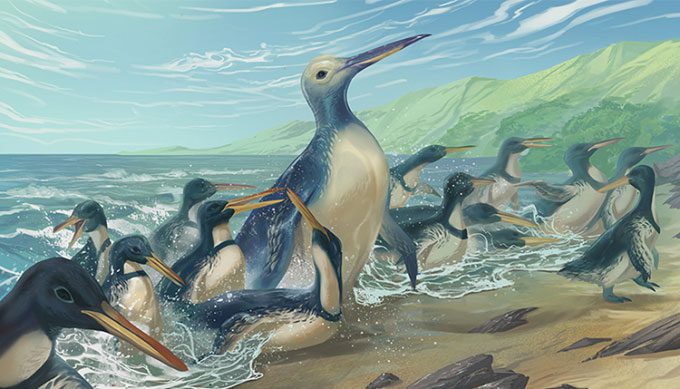A fossil over 55 million years old in New Zealand reveals a previously unknown species of giant penguin weighing 154 kg.

Lead researcher Daniel Ksepka stands next to a model depicting the newly discovered giant penguin species. (Photo: Bruce Museum).
In a study published in the journal Paleontology on February 8, paleontologists named the new prehistoric penguin species Kumimanu fordycei. Its fossil was found alongside eight other specimens within rocks dated to be 55.5 – 59.5 million years old on the North Otago beach of New Zealand’s South Island.
Based on the size and bone density of the fossil compared to modern penguins, it is estimated that Kumimanu fordycei could weigh up to 154 kg, making it the largest known penguin species. For comparison, a 20-year-old male in the United States weighs an average of 90 kg. Due to the incomplete skeleton, researchers are uncertain about the height of the creature.
Previously, the largest recorded penguin species was Palaeeudyptes klekowskii, which lived in Antarctica 37 million years ago. They weighed about 116 kg and stood 2 meters tall. The next largest species is Kumimanu biceae, weighing approximately 121 kg and standing 1.8 meters tall.
Among the eight other penguin specimens excavated in North Otago, there is also a new species named Petradyptes stonehousei. It weighs about 50 kg, just slightly larger than the living emperor penguin.
The two new species may represent some of the earliest ancient penguins, thus this discovery could shed light on how giant penguins evolved over time.

Model of the penguin Kumimanu fordycei (largest) surrounded by a flock of Petradyptes stonehousei. (Photo: Simone Giovanardi/Bruce Museum)
“Kumimanu fordycei and Petradyptes stonehousei have relatively primitive flipper bones, similar to those of birds capable of flying and using their wings to propel themselves while swimming, such as ducks and albatrosses. However, both new penguin species were flightless,” said Daniel Ksepka, the first author of the study and a paleontologist at the Bruce Museum in Greenwich, in an interview with Live Science.
Penguins may have lost their ability to fly to dive underwater around 60 million years ago, not long before the emergence of the two new species. Therefore, these early penguins had not yet developed the effective flippers seen in later penguin species.
The size of K. fordycei suggests that gigantism developed very early in the penguin lineage. This indicates that the advantages of larger size, such as thermoregulation and more efficient diving, created strong selective pressure on penguins soon after they lost the ability to fly.
Researchers speculate that the unique environmental conditions of ancient New Zealand played a significant role in the emergence and flourishing of giant penguins.





















































